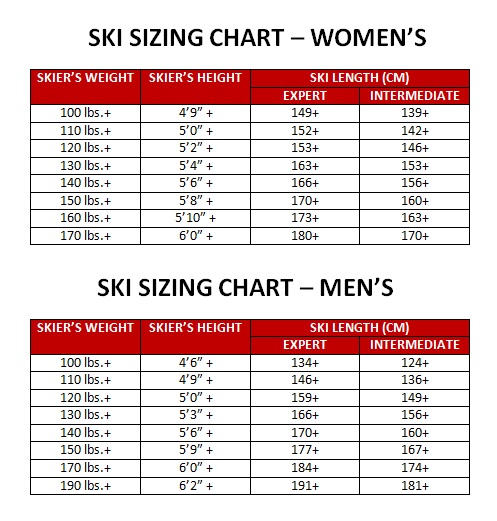Ready to carve up the slopes with confidence and grace? Choosing the right ski size is paramount to maximizing your performance and enjoyment. This comprehensive guide will unravel the complexities of women's ski sizing charts, empowering you to make informed decisions and dominate the mountain.
Finding the perfect ski size isn't just about your height and weight; it's a nuanced process that considers your skill level, skiing style, and personal preferences. A correctly sized ski will enhance your control, stability, and overall skiing experience, while an ill-fitting pair can lead to frustration and even injury. Whether you're a seasoned pro or a beginner, understanding the nuances of women's ski sizing is essential.
Historically, ski sizing was largely generalized, with minimal consideration for gender-specific differences. However, as the sport evolved and women's participation increased, the need for specialized sizing became apparent. Women's skis are often designed with lighter materials and slightly different flex patterns to accommodate their typically lower center of gravity and varying muscle mass compared to men. Today, women's specific ski sizing charts provide a more tailored approach, ensuring a more comfortable and efficient ride.
One of the main issues with women's ski sizing is the lack of standardization across brands. While most manufacturers offer their own sizing guidelines, there can be variations in how they account for factors like skill level and terrain preference. This can make it challenging for women to compare skis across different brands and choose the best fit. Furthermore, understanding the terminology used in ski sizing charts, such as sidecut radius and waist width, can be daunting for those new to the sport.
A women's ski sizing chart typically considers factors like height, weight, skill level, and preferred skiing style. Height and weight serve as a baseline for determining the appropriate ski length, while skill level and skiing style influence the choice of ski width and flex. For instance, a beginner skier might benefit from shorter, more forgiving skis, whereas an advanced skier might prefer longer, stiffer skis for greater speed and stability.
Understanding the implications of ski length is crucial. Shorter skis are generally easier to maneuver and control, making them ideal for beginners and those who prefer groomed runs. Longer skis provide greater stability at higher speeds and are better suited for advanced skiers tackling challenging terrain. Ski width, particularly at the waist, also plays a significant role. Wider skis provide better floatation in powder snow, while narrower skis excel on groomed slopes.
Three key benefits of using a women's ski sizing chart are: enhanced control, improved performance, and reduced risk of injury. Properly sized skis allow for greater precision and maneuverability, giving you more control over your turns and movements. This improved control translates to better performance on the slopes, allowing you to ski with more confidence and efficiency. Finally, correctly sized skis reduce the risk of injury by minimizing strain on your legs and joints.
To find the right ski size, start by consulting a reputable women's ski sizing chart. Input your height, weight, and skill level to get an initial recommendation. Then, consider your preferred skiing style and terrain. If you primarily ski on groomed runs, a narrower ski might be suitable. If you enjoy venturing into powder, a wider ski will provide better floatation.
Advantages and Disadvantages of Standardized Sizing
| Advantages | Disadvantages |
|---|---|
| Easier comparison between brands | May not account for individual body types and preferences |
| Simplifies the selection process | Could lead to ill-fitting skis for some women |
One best practice is to demo different skis before making a purchase. This allows you to experience firsthand how different sizes and models perform on the snow. Another best practice is to consult with a ski shop expert. They can provide personalized recommendations based on your individual needs and preferences.
Common challenges include inconsistency between brands and difficulty interpreting sizing charts. Solutions include trying skis from different brands and seeking expert advice. Frequently asked questions often revolve around the impact of boot size, weight fluctuations, and varying skill levels on ski sizing. Understanding these factors is critical for achieving the perfect fit.
In conclusion, choosing the right skis is essential for a positive skiing experience. By utilizing women's ski sizing charts and understanding the factors that influence ski size, you can enhance your performance, enjoyment, and safety on the slopes. Don't hesitate to seek expert advice and demo different skis before making a purchase. Invest the time to find the perfect fit, and you'll be rewarded with unforgettable days on the mountain.
women's ski sizing chart - Trees By Bike
What Ski Equipment Do I need - Trees By Bike
Ski Length Chart Men - Trees By Bike
Ski Boot Chart Size - Trees By Bike
Kids Ski Length Chart - Trees By Bike
Ladies Ski Size Chart Store - Trees By Bike
Karhu Cross Country Ski Sizing Chart at Helen Ryan blog - Trees By Bike
Ski Length Chart For Women - Trees By Bike
Snow Ski Sizing Chart - Trees By Bike
Atomic Cross Country Ski Boots Size Chart at Veronica Banks blog - Trees By Bike
Ski Pole Sizing Chart - Trees By Bike
Ski Boot Size Chart Women - Trees By Bike
Snow Ski Sizing Chart - Trees By Bike
Ladies Ski Size Chart on Sale - Trees By Bike
In der Dämmerung Modus Tasche salomon ski size chart nordic heilen - Trees By Bike














